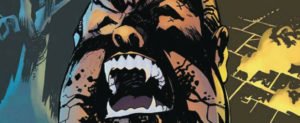Writer: J. Michael Straczynski
Artist: Jesus Saiz
Marvel Comics, November 2023

For non-American readers, buying an issue of Captain America can be akin to taking a sip from a stranger’s teacup. Will it be jingoistic in a way which is mostly alien to the foreign audience? The red-white-and-blue clad superhero was a means by which Joe Simon and Jack Kirby (the characters’ creators) could express and inspire patriotism in the 1940s. Writer Chris Claremont had Captain America note in a story set in the early 1940s, in Uncanny X-Men # 268 (1990), “I’m supposed to be a symbol”. The slightly snide riposte, “Never met onea those before,” from Wolverine, a Canadian mutant, is something that readers outside the United States might well nod in agreement.
The Captain America motion picture (2011) without doubt changed foreign perceptions of the character. Patriotism did not define him. Instead, courage and self-sacrifice fuels Steve Rogers (the man under the mask). When, in the movie, Rogers as a skinny recruit leaps onto a grenade so as to save his comrades, not realising the grenade was inert, people watching the scene outside America suddenly got it. The costume did not set the parameters of the man. Instead, the man set the parameters of the costume.

Captain America #1: Beginnings is a new title from publisher Marvel Comics. Written by veteran writer (and film maker) J. Michael Straczynski, the story slides between Steve Rogers’ current life in his old brownstone apartment building on the Lower East Side of Manhattan, and Rogers’life in his mid-teens, in 1936, in the same building. Rogers’ father passed away not long after World War One, and his mother passed away in ’36 when Rogers was 14. We find out that Rogers had to leave his family’s home because he could not pay the rent. The kindly building manager, Mr Mueller, offered to store some of his mother’s effects, but otherwise, Rogers lives on the street. With a few boxes, a battered suitcase, and a rug, Rogers sleeps in a condemned building on a dirty concrete floor. Rogers works five jobs, hauling rubble, selling newspapers, cleaning cars, walking dogs and packing groceries. He rarely eats. In the present, Rogers stands back and looks up at his family home, and thinks back to when he was evicted. Mr Mueller tries to give the lean 14 year old comfort.
“She used to watch you from up there, you know. When you went to school in the morning, and when you came home in the afternoon. Like she was taking a picture of it in her head…. She watched you every day because when the ground shifts suddenly beneath us, we rarely have time for those last looks.“
Rogers replies,
“I knew she watched. But I didn’t want her to know I knew. So I’d wait until she turned away… An then I’d look back. for the same reason. And then the ground shifted.”
The adult Rogers, who in other moments is the superhero with the indestructible shield, looks up at the window, and in the next panel, wipes a tear. The American dream should not involve an orphaned boy, starving and sleeping alone in a ruined factory. It is heart-tugging, and a remarkable scene from Mr Straczynski and artist Jesus Saiz. (Mr Straczynski has been preoccupied with the plight of the homeless for a long time, writing the comic book title Midnight Nation in 2000-2002. Part of the premise of Midnight Nation was that the homeless, ignored and shunned by passers-by, eventually disappear into a shadow land.)
By 2023, Rogers’ building is in a state of severe disrepair. The building’s owners have started evicting the tenants with a view to demolition. Faced with watching his neighbours being forced out onto the street, Rogers instead borrows money from his billionaire friend Tony Stark and buys the building (mirroring the actions of Clint Barton in 2013’s Hawkeye #1). Rogers also hires a homeless tradesman named Kim, who is living with his family in his van, to help renovate the building.

Towards the end of this first issue, bouncing back to 1936, Rogers is directed by a stranger to a nearby rally. The rally is being held by the German American Bund, the American arm of the Nazi Party. It is an uncomfortable piece of American history that, prior to the war, Nazism was a popular ideology in the US. Seeing the Nazi swastika lined up to the American flag even in a mainstream comic is a startling sight to the modern reader, but not so much to the citizens of pre-war America. It seems Mr Straczynski is keen to explore the factors leading to Rogers’ impeccable moral compass.
Outside of all of that, Captain America fights a giant robot jackal, assists the superhero team the Fantastic Four in repelling a sub-atomic army, and foils a good old fashioned armed robbery. There is plenty of action, fluidly rendered by Mr Saiz. And a demon named Asmoday is lurking in background, building an army of criminal scientists. This is, after all, an American superhero comic.
But set that to the side. This comic is excellent. It is not the costume which makes Captain America. The issue reveals that it is grit, adversity, courage, and kindness which makes the man a hero.

